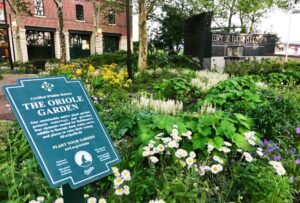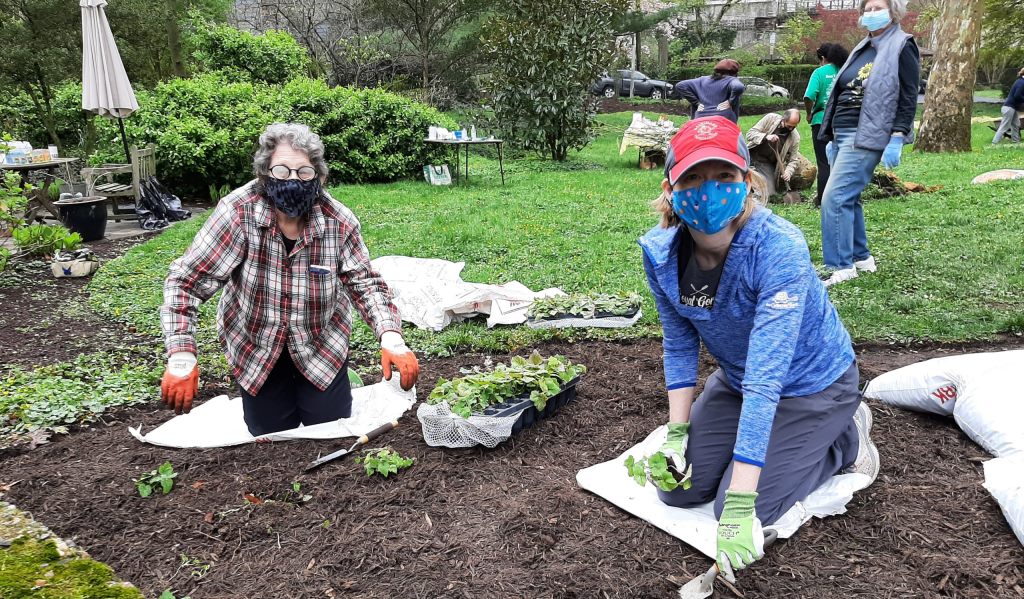On June 24, 2022, the Chesapeake Bay Trust, in partnership with the U.S. Environmental Protection Agency (EPA), and the West Virginia Department of Environmental Protection announce that $1,058,720 in funding has been awarded to 13 projects across Maryland, Pennsylvania, Virginia, and West Virginia as part of the Chesapeake Bay Green Streets, Green Jobs, Green Towns Grant Program.
These awards help communities develop and implement plans that reduce stormwater runoff; increase the amount of green spaces in urban areas; improve the health of local rivers, streams, the Chesapeake Bay and the human populations within the communities; create “green jobs;” reduce energy use; and enhance livability in cities and communities.
“We congratulate all grantees for putting forth projects that will support clean water and strong neighborhoods,” said EPA Mid-Atlantic Regional Administrator Adam Ortiz. “This program helps communities reinvigorate gray and green infrastructure projects that reduce stormwater runoff and pollution to local waters and the Chesapeake Bay, while improving their economy, quality of life and community beautification.”
 Chesapeake Bay Trust leaders say that their organization envisions a restored and protected Chesapeake Bay watershed and other natural resources in the region, from the Coastal Bays to the Chesapeake to the Youghiogheny River. They empower local community-based groups on the ground with the resources they need to take on a meaningful and measurable role in restoring forests, streams, rivers, bays, wildlife, and more in their own communities.
Chesapeake Bay Trust leaders say that their organization envisions a restored and protected Chesapeake Bay watershed and other natural resources in the region, from the Coastal Bays to the Chesapeake to the Youghiogheny River. They empower local community-based groups on the ground with the resources they need to take on a meaningful and measurable role in restoring forests, streams, rivers, bays, wildlife, and more in their own communities.
Every year, the Trust empowers about 400 groups by providing grants and technical assistance to accomplish environmental education, community outreach, and local watershed restoration projects. The Trust is supported by the sale of the Chesapeake Bay license plate; donations to the Chesapeake Bay and Endangered Species Fund on the Maryland State income tax form; donations made by hunters, fishers, and boaters in the Maryland online natural resource licensing system; donations from individuals and corporations; and partnerships with private foundations and federal, state, and local governments. On average, 90% of the Trust’s expenditures are directed to its restoration and education programs.
This green infrastructure program is designed to facilitate and encourage communities implementing traditional “gray” infrastructure projects, such as repaving roads or reconfiguring intersections, to add green elements at little additional cost. These green elements then offer cost-effective savings on stormwater treatment, flooding abatement, and other community benefits.
“The projects announced today show the value of adding green stormwater elements when other infrastructure improvements are planned,” said Alana Hartman, West Virginia Department of Environmental Protection’s Potomac Basin Coordinator. “These projects, led by communities and local organizations, will serve as a model for the entire region while helping to protect, preserve and enhance the quality of our water resources in the South Branch of the Potomac and the Chesapeake Bay Watershed.”
The Green Streets, Green Jobs, Green Towns Initiative was started in 2011, led by water experts at EPA and then expanded into the program it is today. To date, 245 projects have received funding and $14.4 million has been invested into greening communities.
Greening local communities has been shown to have multiple human benefits, from savings on energy costs that hit the wallet via provision of shade to reduction of illnesses to reduction in crime. Studies show that time spent outdoors in green spaces leads to improved mental health, reduced absenteeism in employees, improved heart health, and more.
“Green infrastructure projects are one of those rare win-win-win scenarios: They improve communities in various ways, they improve human health, and they also benefit our waterways,” said Dr. Jana Davis, president of the Chesapeake Bay Trust. “This program lets us take advantage of projects that communities want to do for themselves that just also happen to benefit the larger natural system way downstream.”
Here are the new Green Streets, Green Jobs, Green Towns Grant Program awardees:
Town of Millington, Maryland – $9,995
A concept plan to treat stormwater runoff from impervious surfaces, environmental restoration, and pervious parking enhancements, while improving public access and opportunities via a kayak launch and shoreline improvements to the properties owned by the Town along the Chester River.
City Neighbors Foundation, Baltimore, Maryland – $148,883
A complete green renovation of the City Neighbors Charter parking lot, located in NE Baltimore City. Installations include 1270 sq. ft. of micro-bioretention, 1679 sq. ft. of pervious paving, and a 105 sq. ft. rain garden, all of which will be open for exploration by students, their families, and the general public.
Borough of Chambersburg, Pennsylvania – $150,000
A project that will directly reduce stormwater runoff into the Conococheague Creek, reduce associated flooding in the immediate area, address bank stabilization, and implement green infrastructure components. Major enhancements to the area include the reduction of Hood Street flooding; the installation of sub-surface infiltration beds to manage stormwater; the planting of pollinator gardens; and the removal of invasive species and planting native riparian buffers.
City of Romney, West Virginia – $118,555
A water filtration project to be located in Romney, West Virginia that will be funded through new program partner, West Virginia Department of Environmental Protection. The project will retrofit a large parking lot and adjoining streets with water filtering bioswales. Runoff will be filtered from 3.3 acres of drainage area, 0.85 acres of which is impervious. The filtration system will address the issue of unfiltered runoff into a nearby stream which flows less than one mile into the South Branch of the Potomac River.
Druid Heights Community Development Corporation, Baltimore, Maryland – $29,998
An engineering design to reduce the amount of stormwater runoff going into the Jones Falls watershed and the Chesapeake Bay. The design will create a community-envisioned greening plan that will incorporate trees, bioswales, and other stormwater management facilities. The design will be created with the residents as part of their overall vision for the West Baltimore neighborhood.
James River Association, Petersburg, Virginia – $118,146
The implementation of a critical component of green and gray infrastructure for the Lakemont community which will better manage stormwater and improve local water quality. The proposed Nash Street Grassy Swale project represents a continued commitment to implement infrastructure improvements for Lakemont which will enhance existing conditions, reduce the volume of stormwater runoff, and treat water quality.
Joe’s Movement Emporium/World Arts Focus, Mount Rainier, Maryland – $150,000
The implementation of stormwater management practices at Joe’s arts center, as part of “Story of Water and Art.” Stormwater management features – green roof, vertical rain gardens, and green roof demonstration unit – will resolve flooding issues around the urban property, and be integrated with native plants, educational signage, a mural, and outdoor program space.
ShoreRivers, Preston, Maryland – $24,122
A design of conservation improvements to the James T. Wright Memorial Park, adding bioswales to alleviate overly-saturated conditions, tree canopy to beautify and cool community gathering areas, and conservation meadows to enhance the beauty of the park and increase pollinator habitat.
The Community Ecology Institute, Columbia, Maryland – $108,650
The implementation of the engineered plans associated with Atholton high school, which will provide highly visible demonstrations of best management practices, achieve health benefits for the Middle Patuxent Watershed, address chronic neighborhood stormwater flooding, and provide an outdoor education space for the school community.
Town of Emmitsburg, Maryland – $121,400
The installation of a forebay and micropool with pilot channels and wetland area within the existing dry extended detention pond footprint to provide water quality controls for the 7.96-acres of impervious area while also providing water quantity controls for the 22.22-acre drainage area without increasing discharge flow rates.
Town of Galena, Maryland – $30,000
An engineered design plan that identifies potential solutions to address stormwater runoff that causes localized flooding in the area of Division Street and a parking area behind a local grocery store and delicatessen. Along with using green infrastructure practices such as bioretention, green infrastructure will be utilized to help improve the flow of traffic in and through the area as well to screen adjoining properties.
Town of Glen Echo, Maryland – $28,271
The design of two stormwater remediation projects, a rain garden at Town Hall and a swale in the right of way, that will address town flooding issues.
Watershed Alliance of York, York and Lancaster Counties, Pennsylvania – $20,700
A two-part workshop and repeatable workshop template that will focus on the responsibilities of Homeowner Associations (HOAs) in York and Lancaster counties for their stormwater management infrastructure. One important deliverable will be a template that groups such as watershed organizations can use to easily plan and conduct this workshop/charrette in counties throughout the Bay watershed.
Photo courtesy of Chesapeake bay Trust.

